† Corresponding author. E-mail:
Dedicated to the 80th birthday of Prof. Jing Zhu.
Heterogeneous catalysts are the most important catalysts in industrial reactions. Nanocatalysts, with size ranging from hundreds of nanometers to the atomic scale, possess activities that are closely connected to their structural characteristics such as particle size, surface morphology, and three-dimensional topography. Recently, the development of advanced analytical transmission electron microscopy (TEM) techniques, especially quantitative high-angle annular dark-field (HAADF) imaging and high-energy resolution spectroscopy analysis in scanning transmission electron microscopy (STEM) at the atomic scale, strengthens the power of (S)TEM in analyzing the structural/chemical information of heterogeneous catalysts. Three-dimensional reconstruction from two-dimensional projected images and the real-time recording of structural evolution during catalytic reactions using in-situ (S)TEM methods further broaden the scope of (S)TEM observation. The atomic-scale structural information obtained from high-resolution (S)TEM has proven to be of significance for better understanding and designing of new catalysts with enhanced performance.
Most industrial catalytic processes occur in heterogeneous systems, the chemical reactions initiate at the interface between the catalyst nanoparticles and the reaction media, whereas mass transport may occur over several atomic layers localized on the exposed surface of the catalysts. Subtle changes of the surface structures at the nanometer or atomic scale would thus have significant effects on the catalytic efficiency. In addition, for supported heterogeneous catalysts, the interaction between the active metal nanoparticles and the support materials also play a critical role in defining the catalytic performance.[1,2] Such metal–support interaction has also been used to tune the structure of the supported metal species, with the ultimate goal of constructing “single-atom catalysts” where every single precious metal atom can be dispersed onto the surface of the support materials and participate in catalytic reactions.[3] This has become an important trend in advanced catalyst research, promising a way to increase the utilization efficiency of the noble metal. Meanwhile, this poses a major challenge for unveiling the detailed structure of advanced heterogeneous catalysts, and characterization techniques with atomic resolution and single atom sensitivity become indispensable.
Conventional imaging and spectroscopy by optical or x-ray based techniques only gather the averaged structural and chemical information from a relatively bulk volume and cannot provide local structural/compositional information at the atomic scale. By using high-energy electron beams as the “light source”, transmission electron microscopes in principle offer the opportunity to achieve picometer-scale spatial resolution, although in practice the spatial resolution is severely limited by many factors including aberrations from the imperfect magnetic lens.[4] With the help of advanced aberration correctors, the state-of-the-art (scanning) transmission electron microscopes ((S)TEM) can nowadays routinely perform imaging with sub-ångström spatial resolution,[5] and imaging and spectroscopy at the single-atom scale have become feasible with aberration-corrected STEM even under low accelerating voltage.[6,7] These technical advances enable analytical TEM as a powerful tool for structural analysis of heterogeneous catalysts.
Heterogeneous catalytic reactions occur primarily on the surface and interface. Thus, as the size of the nanoparticles dispersed on support materials decreases, the increasing exposed surface could provide more active sites for catalytic reactions. The ultimate condition is that individual isolated atoms are dispersed or anchored on the supports, namely, single atom catalysts (SACs) are formed.[3,8,9] Abbet et al.[10] studied Pdn clusters (
The emergence of SACs brings forward new challenges in understanding the structure-property relationships for heterogeneous catalysts, because the signals from single atoms are too weak to be detected by conventional characterization techniques. Hence, development of new imaging methods to directly probe the precise location of individual atoms with ultrahigh spatial resolution and spectroscopy methods to collect chemical information with single-atom sensitivity is of particular importance. STEM-HAADF imaging has an intrinsically higher resolution than coherent HRTEM and can directly represent heavy atoms on relatively light supports, due to its incoherent Z-contrast nature. Advanced STEM-HAADF imaging has already achieved a sub-ångström resolution with the adoption of aberration correctors, which has been widely applied to characterizing SAC systems, such as individual Pd atoms on ultrathin TiO2 sheets,[12] isolated Ni sites on MOFs[13] and single Fe dispersed in Fe–N–C catalyst.[14] By correcting the geometry aberrations of the probe forming lenses, aberration correctors in STEM decrease the probe size and help to achieve a high probe current in a sub-ångström probe, which provides the possibility to identify single Si and Pt atoms on graphene via energy dispersive x-ray spectroscopy (EDXS).[7] In addition, electron energy loss spectroscopy (EELS) in STEM has become a powerful method for atomic-scale chemical identification and measurement of bonding information, such as determination of two different bonding configurations from individual impurity Si atoms in graphene,[6] confirming single nitrogen dopants in graphene[15] and mapping out the spatial distributions of individual Li atoms in carbon nanotubes.[16] Here we will discuss a few recent examples to illustrate the application of STEM imaging and spectroscopy analysis on the studies of single atom catalysts.
Low-temperature hydrogen production is important for polymer electrolyte membrane fuel cells (PEMFCs) which are considered as a kind of zero-emission devices. In order to accelerate the rate of H2 production, water, and carbon-containing sources should both be activated efficiently, and supported catalysts with bifunctional structures have attracted intense research interests in this field. Recently, Ma and co-workers reported two interesting studies on noble metal catalysts supported on α-MoC for low-temperature hydrogen production, where the atomic structures of the active metal species are directly revealed using atomic-resolution STEM-HAADF imaging. In the first study, Lin et al. synthesized a series of platinum (Pt)/α-MoC catalysts as well as Pt on different supports, and found out that the Pt/α-MoC catalyst with 0.2% Pt loading showed the best H2-producing catalytic activity at low temperature, owing to its single Pt atom dispersion on α-MoC support.[17] Atomic-resolution STEM-HAADF images of the 0.2% Pt/α-MoC catalyst verified the fact that Pt metal disperses atomically on the α-MoC surface, as highlighted in red in Fig.
 | Fig. 1. (color online) STEM-HAADF characterization of highly dispersed noble metals on MoC support. High-resolution STEM-HAADF images of fresh 0.2% Pt/α-MoC (a) and used 0.2% Pt/α-MoC catalysts (b).[17] High-resolution STEM-HAADF images of fresh 2% Au/α-MoC (c), used 2% Au/α-MoC catalysts (d), and the NaCN-leached specimen (inset in Fig. |
The water-gas shift (WGS) reaction is another approach to produce hydrogen at low temperature, and Yao et al. developed an excellent Au/α-MoC catalyst for this reaction.[18] STEM-HAADF imaging was again the key to revealing the atomic structure of the active species in this novel catalyst. STEM-HAADF images show that there are two different Au configurations on the α-MoC surface: individually dispersed Au atoms and Au layered clusters (labeled by blue and yellow in Fig.
As can be seen from the two examples discussed above, single atoms dispersed on a suitable support surface can indeed form an active catalyst. However, it is not always the case that single atoms with the highest dispersion are catalytically more active than other structures, as illustrated in the case of Au/α-MoC for low-temperature WGS. Nevertheless, characterization techniques that can clearly visualize surface structures down to the single atom level are crucial in order to uncover all the possible active site structures and identify the catalytically most active ones. STEM-HAADF imaging provides a feasible way for this purpose, and the atomic structural information obtained from STEM imaging can serve as valuable inputs for first-principles calculations to deduce the correlation between the atomic configuration and catalytic performance, as also illustrated in the two studies discussed above.
Apart from the supported noble metal nanoparticle catalysts, two-dimensional based catalysts are another family of catalysts that require microscopy imaging and spectroscopy analysis with single-atom resolution and sensitivity.
MoS2-based nanomaterials are widely used for industrial hydrodesulfurization reactions, and their catalytic activity is mostly contributed by the edges of the layered materials. It has been well demonstrated that the catalytic activity of MoS2-based catalysts can be promoted by doping the edge sites with other elements (e.g., Co or Ni).[19–21] Identifying the precise location of these substituting dopant atoms can provide us guidance for understanding the catalytic mechanism and designing new catalysts with superb performance. However, conventional (S)TEM techniques with the accelerating voltage exceeding 100 kV generally cause undesired damage to such two-dimensional materials, which may mislead our interpretation of the (S)TEM images. Thus, the application of low-voltage aberration corrected STEM method is crucial for atom-level analysis of beam-sensitive catalysts.
An elegant application of the low-voltage STEM imaging and spectroscopy analysis was reported by Zhu et al., where 60 kV STEM-HAADF imaging, assisted by simultaneous EEL spectrum imaging, was applied to uncover the preferential incorporation of Co-promoter atoms along different crystallographic edges in a Co-promoted MoS2 catalyst.[22] To determine the precise atomic structure and stoichiometry of Co-substituted S edges, sub-Å STEM-HAADF imaging and spatial-resolved EEL spectra were conducted (Fig.
 | Fig. 2. (color online) STEM imaging and spectroscopy analysis of MoS2 based catalysts at the single atom level. (a) High-resolution STEM-HAADF image of the S-zigzag edge in Co–Mo–S catalyst and the corresponding EELS mapping (b) of Mo (in blue) and Co (in red) and (c) S (in yellow). (d) The L2,3 edges of a 2S and a 1S atomic columns in (c). (e) Schematic of the Co–Mo–S crystal structure. (g) Combined Mo/Co/Fe mapping from the area framed in black in the STEM-HAADF image (f) and (h) corresponding superimposed ball model.[22] |
Generally, for bulk MoS2, coordinately saturated sites on the basal planes do not exhibit catalytic activity. However, as the number of layers of MoS2 reduces, the exposed basal plane atoms increase and can become active upon doping. Liu et al. reported a new catalyst by incorporating single Co atoms onto the basal plane of monolayer MoS2 and distinguished Co atom substitution behavior before and after catalytic hydrodeoxygenation (HDO) reaction.[23] STEM-HAADF imaging revealed that some sites in monolayer Co-SMoS2 produce higher image contrast than the nearby Mo and S2 sites as shown in Fig.
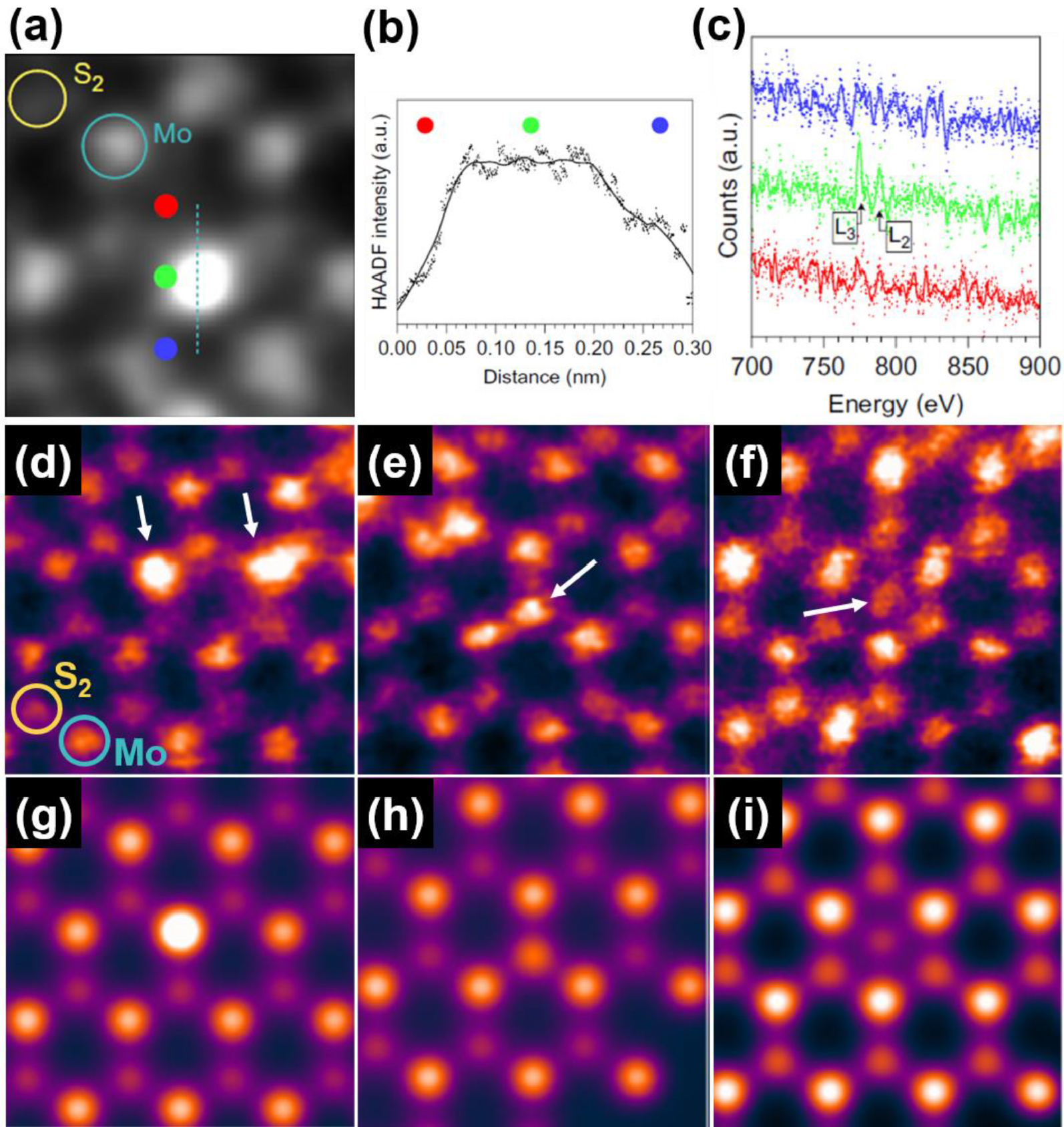 | Fig. 3. (color online) STEM-HAADF images and spectra of the Co-SMoS2 catalyst. (a) The magnified STEM-HAADF image of fresh Co-SMoS2. (b) The corresponding HAADF intensity line scanning in (a). (c) The simultaneous EELS acquired along the line in (a). (d) The HAADF image of Co sitting on the Mo-atop site (marked in white arrow) in fresh catalysts. (e) HAADF image of Co-substituted S site (marked in white arrow) in used catalysts. (f) The HAADF image of Co occupying in the hollow site (marked with white arrow) in used catalysts. ((g)–(i)) The corresponding simulated HAADF images, respectively.[23] |
Oxygen reduction reaction (ORR) plays a key role in polymer electrolyte fuel cells (PEFCs), and noble platinum-group metals have been widely used in this field due to their good oxygen reduction activities, which causes PEFCs costly. Thus, searching for non-precious metal catalysts is significant for large-scale commercialization of fuel cells-powered vehicles. Since Jasinski[24] observed the catalytic activity of cobalt phthalocyanine for ORR in 1964, inexpensive metal–nitrogen–carbon (M–N–C, M = Fe, Co, etc.) compounds[25–27] have been considered as a promising alternative to Pt-based catalysts. In Fe (or Co)–N–C systems, determining the local coordination between metal and nitrogen atoms can provide a deeper understanding for their catalytic mechanism, and low-voltage STEM imaging and EELS analysis show an advantage in such characterization.
Li et al. synthesized a novel ORR electrocatalyst of few-walled carbon nanotube–graphene (NT–G) complexes and found out that iron impurities and nitrogen doping of this structure are both important to the improved ORR electrocatalytic activity.[28] The STEM-ADF image (Fig.
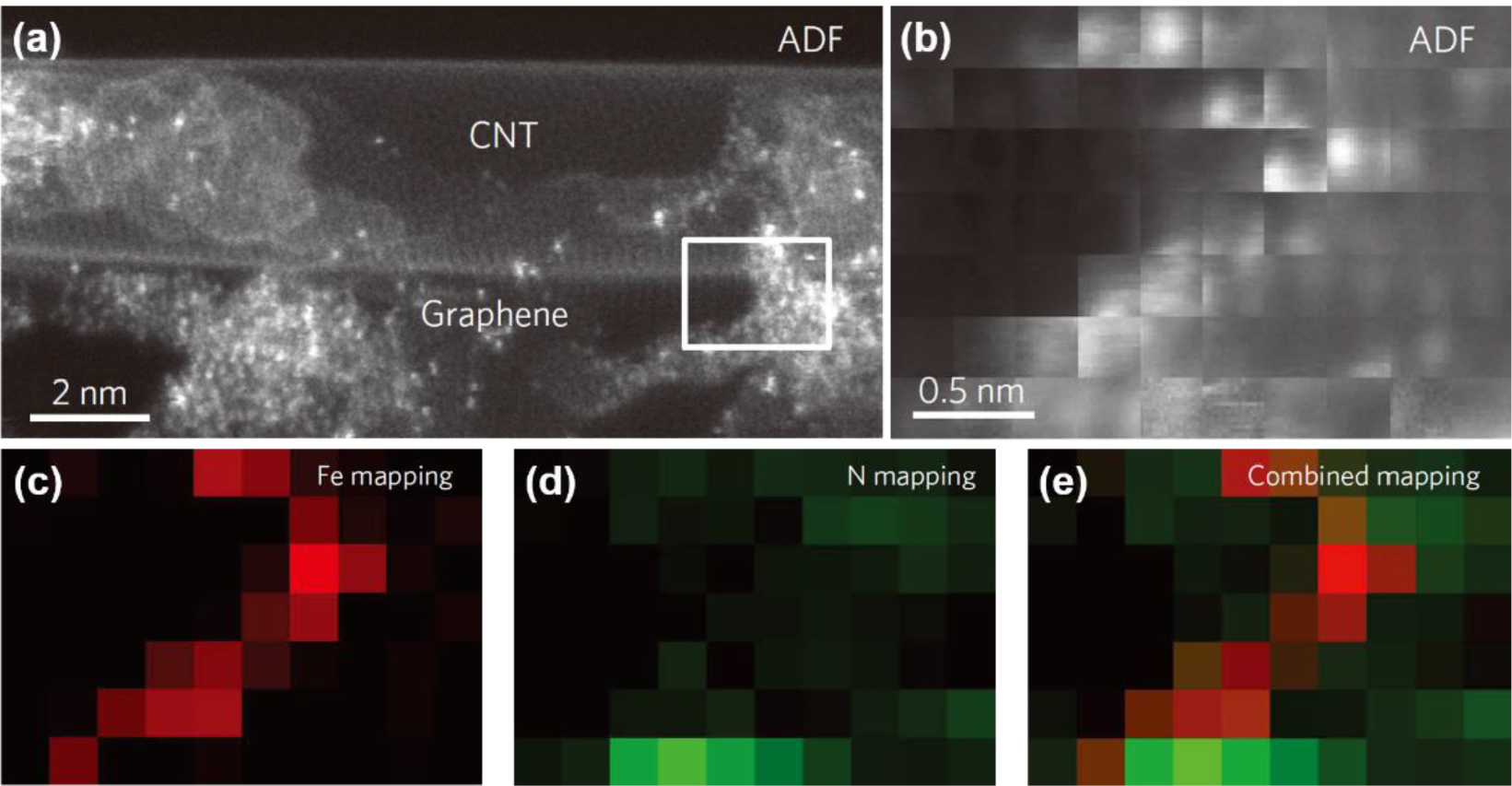 | Fig. 4. (color online) STEM imaging and spectrum imaging of a CNT–graphene based catalyst for ORR. (a) STEM-ADF image of the NT–G complexes. (b) Simultaneously acquired ADF image, (c) Fe EELS mapping, (d) N EELS mapping, and (e) the overlaid Fe and N EELS signals from the white framed area in panel (a).[28] |
Limited by the complex NT–G structure and the under-sampling setting of the STEM-EEL spectrum imaging experiment of that time, the abovementioned results did not provide direct visualization of the chemical bonding configuration of the single Fe and N atoms. A more recent study by Chung et al. has moved the study one step forward and proposed FeN4 in graphene lattice as the active site using a combination of STEM-ADF imaging, EELS analysis and DFT calculations.[29] In this work, the (cyanamide+polyaniline)-iron-carbon catalyst ((CM+PANI)-Fe-C)) with a hierarchical porous structure was synthesized, and the atomic resolution STEM-ADF image (Fig.
 | Fig. 5. (color online) Atomic-scale STEM analysis of graphene-based catalysts for ORR. (a) STEM-HAADF image of individual Fe atoms in few-layered graphene. (b) The EEL spectra of N K-edge and Fe L-edge from the three points indicated in panel (a). (c) Simultaneously acquired STEM-HAADF image and EELS mapping of Fe (d) and N (e).[29] |
In summary, atomic-scale STEM imaging and EELS analysis can efficiently visualize and identify individual heavy atoms in SACs and catalysts based on two-dimensional materials, which can provide direct evidence for uncovering local atomic configurations and the corresponding chemical bonding information. These are important structural information that can be used directly as input models for theoretical calculations for understanding the underlying catalytic mechanism and can ultimately help to design novel catalysts with excellent performance. Readers interested in this topic are encouraged to refer to recent review articles on (S)TEM study of single-atom catalysts.[9,30]
Images acquired in (S)TEM are two-dimensional projections of the three-dimensional (3D) objects, which inevitably loss structural information in the third dimension.[31,32] As 3D topography information is important for understanding the exposed facets of catalyst particles and mass transport during catalytic reaction, it is of great importance to developing techniques that can provide structural information in three dimensions, especially for materials that possess complicated morphology and spatial variation of chemical composition.[33]
In 1917, Radon showed mathematically how a series of 2D projection images could be converted back to the 3D structural model through the so-called Radon transformation,[34] and many methods have been developed for 3D reconstruction under TEM and STEM imaging modes to date. Compared with TEM mode, STEM-HAADF tomography is more suitable for crystalline materials by suppressing the diffraction effects and can provide chemical information in 3D reconstruction due to its nature of Z-contrast.[35] There are two main 3D reconstruction approaches under STEM-HAADF imaging mode. The first one, known as depth sectioning method, utilizes a focused electron probe with large convergence angle and a very small depth of focus (
One important application of 3D reconstruction is for the study of nanoporous catalysts where the inner surface area of interconnected pores can provide more active sites and increase the mass-based activity.[42,43] Geboes et al. used the STEM-HAADF electron tomography to unveil the 3D porous structure of Pt nanocatalysts synthesized by electrodeposition at different overpotentials.[44] The 3D reconstruction image of the high-overpotential electrodeposited NP in Fig.
 | Fig. 6. (color online) STEM-HAADF tomography reconstruction and cross-sections of nanoparticle catalysts. (a) 3D visualization of the high-overpotential synthesized Pt NPs and (b) a corresponding slice image, (c) 3D visualization of the low-overpotential synthesized Pt NPs and (d) a corresponding slice image.[44] (e) A series of progressing cross-section images of a CoOx/SiO2 nanocatalyst.[45] |
In another example, Xin et al. applied STEM-HAADF tomography to study the porous structure of binary CoOx/SiO2 nanoparticles, where the HAADF intensity was used to differentiate the heavier CoOx component from the lighter SiO2.[45] The 3D reconstruction results clearly unveil that the nanocatalyst consists of a CoOx core with an interconnected nanoporous network and a SiO2 shell, which facilitates the infiltration of gas molecules like hydrogen during catalytic reactions, shown in Fig.
The two examples mentioned above used a reconstruction algorithm called simultaneous iterative reconstruction technique (SIRT). The reconstruction quality is mainly determined by the quantity of the 2D projections, and a large number of projections is needed in order to assure a high fidelity.[46] The spatial resolution achievable in these two examples is around 1 nm, which limits more detailed information to be extracted from the 3D reconstruction. Combing discrete tomography, which uses a small number of atomic resolution projections taken along different zone axes of crystalline samples, with new reconstruction algorithms, 3D reconstruction with atomic resolution can be achieved.[47]
Recently, Goris et al. put forward a compressive sensing based reconstruction algorithm, also known as total variation minimization (TVM), to characterize the surface facets of Au nanorods.[48] The TVM method can reconstruct the atomic lattice faithfully from a limited number of projections. Figure
 | Fig. 7. (color online) Atomic-resolution 3D reconstruction of an Au nanorod. (a) The volume rendering image of the reconstructed Au nanorod. (b) Two orthogonal slices extracted from panel (a). (c) The region of a surface step circled in panel (b). (d) The corresponding 3D εzz strain measurement of the two orthogonal slices in panel (a).[48] |
Atomic resolution 3D reconstruction based on discrete tomography requires multiple high-resolution projection images acquired along specific zone axes of the sample, which would not be feasible for samples such as nanodecahedra particles, because only one suitable axis can be available in such structure. To overcome this problem, Goris et al. developed a novel reconstruction algorithm based on modified SIRT reconstruction, where each atom in the Au nanodecahedron is modeled by a 3D Gaussian function and the 3D Gaussian model is further introduced into the reconstruction as prior knowledge.[49] The most important advantage of this method is that all atom coordinates can be obtained and put out directly to calculate the 3D displacement map. Figure
 | Fig. 8. (color online) 2D and 3D analysis of strain distribution of an Au nanodecahedron. The strain distribution is visualized using a color code and scaled between ± 5%. (a) The εxx strain map obtained from a STEM-HAADF projection image. (b) The corresponding lattice displacement along the x-direction. (c) Slice through the εxx volume from 3D reconstruction. (d) The lattice displacement along the x-direction corresponding to panel (c). (e) Slice through the εzz volume from 3D reconstruction. (d) The corresponding lattice displacement along the z-direction.[49] |
STEM-HAADF imaging provides electron tomography with a power of analyzing compositional/chemical information in three dimensions using its Z-contrast nature. Yang et al. reconstructed a FePt nanoparticle based on a series of STEM-HADDF images and proposed an atom tracing and classification method to determine the coordinates of all individual Fe and Pt atoms.[50] Figure
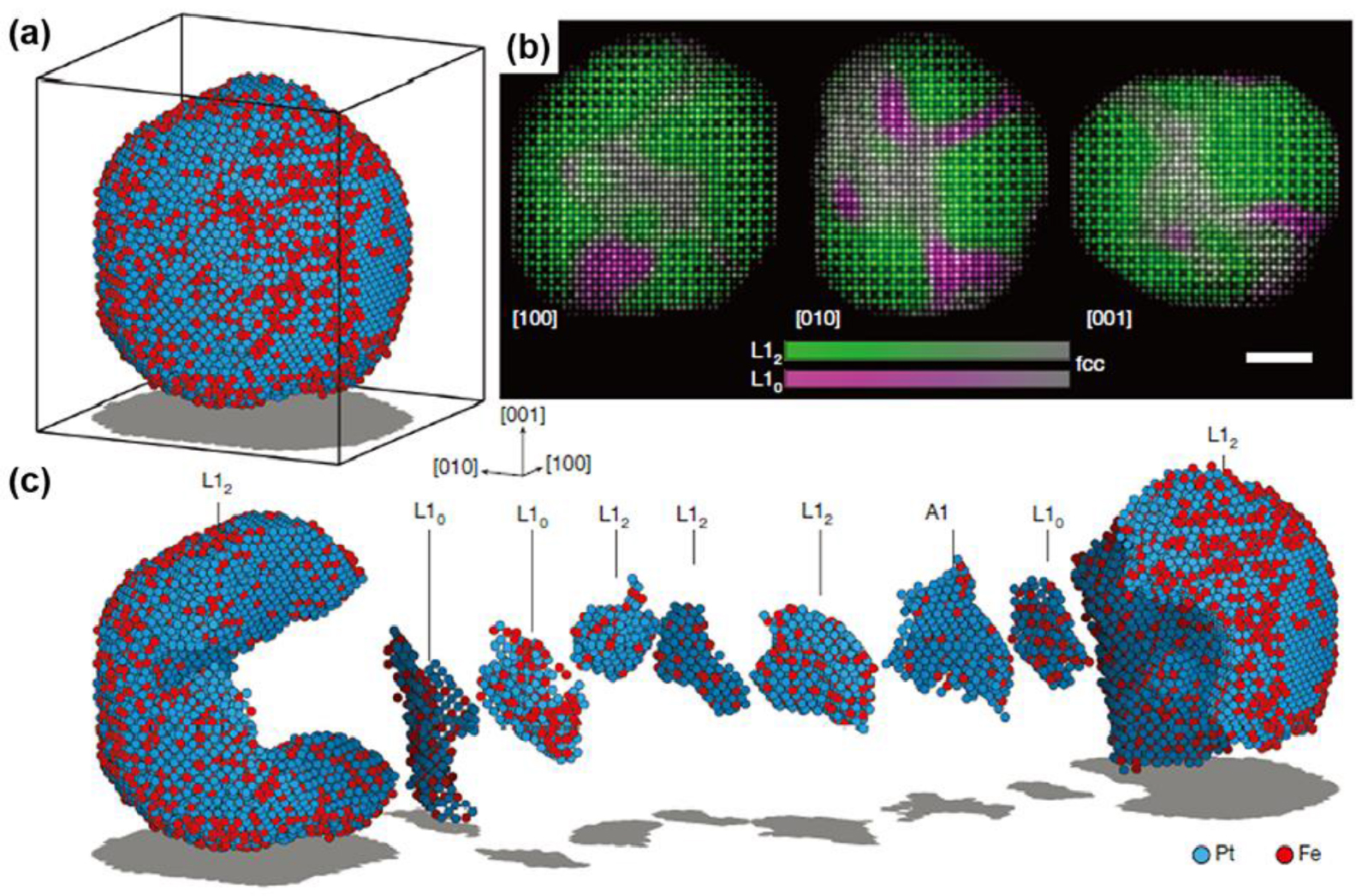 | Fig. 9. (color online) 3D reconstruction of a FePt nanoparticle including 3D atomic positions, elemental identification, and detailed grain structure. (a) The 3D positions of individual atoms of Fe and Pt. (b) Multislice images through the reconstructed 3D atomic model along the [100], [010], and [001] directions. Color bars indicate the degree of ordering, varying between pure L12/L10 and chemically disordered fcc. Scale bar, 2 nm. (c) The nanoparticle consists of two large L12 grains, three small L12 grains, three small L10 grains and a Pt-rich A1 grain.[50] |
In summary, 3D reconstruction techniques based on STEM-HAADF imaging are promising in revealing the 3D structural information, such as porous structure, surface facets, 3D lattice displacement, and atomic coordinates, with a high spatial resolution. It is worth noting that the development of new algorithms such as artificial neural networks can further improve the efficiency of reconstruction by using a very limited number of projection images and simultaneously guarantee the quality of the reconstructed objects.[51] The developments towards highly reliable 3D atomic-scale reconstruction will of no doubt advance our understanding of the structure–activity relationships in heterogeneous catalysts.[52,53]
It is well known that structure of catalysts does change during catalytic reactions. Static structural information obtained under high vacuum and room temperature conditions in conventional (S)TEM may not represent the truly active structure for catalysis. Recording the structural and chemical evolution of catalytic materials under realistic reaction conditions is, therefore, of fundamental importance for unveiling the underlying mechanism and designing of novel catalysts with better performance. To bridge this gap, in-situ (S)TEM techniques have been developed to identify the intermediate structures and to capture structural evolution with atomic resolution under gas and heating conditions that mimic those in real catalytic reactions.
Two different approaches for in-situ (S)TEM experiments have been developed in order to accommodate the gas environment around the specimen into a TEM column that requires high-vacuum. The first approach involves major modification to the microscope column and uses differential pumping system to change a conventional TEM into an environmental TEM (EFEM),[54] as shown in Fig.
 | Fig. 10. (color online) Two different approaches for in-situ experiments using either ETEM or MEMS-based functional holders. (a) Schematic of a differential pumping system in ETEM.[54] ((b)–(d)) Configuration of nanoreactors in the in-situ sample holder.[58] |
The second approach uses specially designed microelectromechanical systems (MEMS)-based cells or nanoreactors, where a thin layer of gas is sealed between two electron-transparent windows, as shown in Figs.
For heterogeneous catalysis with gas reactants, the reaction efficiency largely depends on the surface morphology of the nanocrystals while the reaction gases also affect the surface structure of the catalysts. Therefore, real-time TEM observation of the surface structure evolution at the atomic scale under reaction environments is of particular importance. Zhang et al. investigated the surface amorphization of anatase TiO2 exposed to H2O vapor of 1 Torr at 150 °C at the atomic scale, simulating the conditions of vapor-phase water splitting.[63] The in-situ experiment was conducted in a differentially pumped ETEM and a series of HRTEM images were recorded as shown in Fig.
 | Fig. 11. (color online) In-situ HRTEM imaging of anatase nanocrystals at 150°C. (a) No H2O vapor; ((b)–(e)) exposed to 1 Torr H2O vapor after 1 h (b), 7 h (c), 20 h (d), and 40 h (e); (f) fresh areas only exposed to H2O vapor after 40 h without electron irradiation.[63] |
Surface oxidation and reduction often occur during catalytic reactions. Xin et al. used ETEM to study the structural evolution of Pt–Co nanoparticles during in-situ annealing under O2 or H2 environment.[64] As shown in Figs.
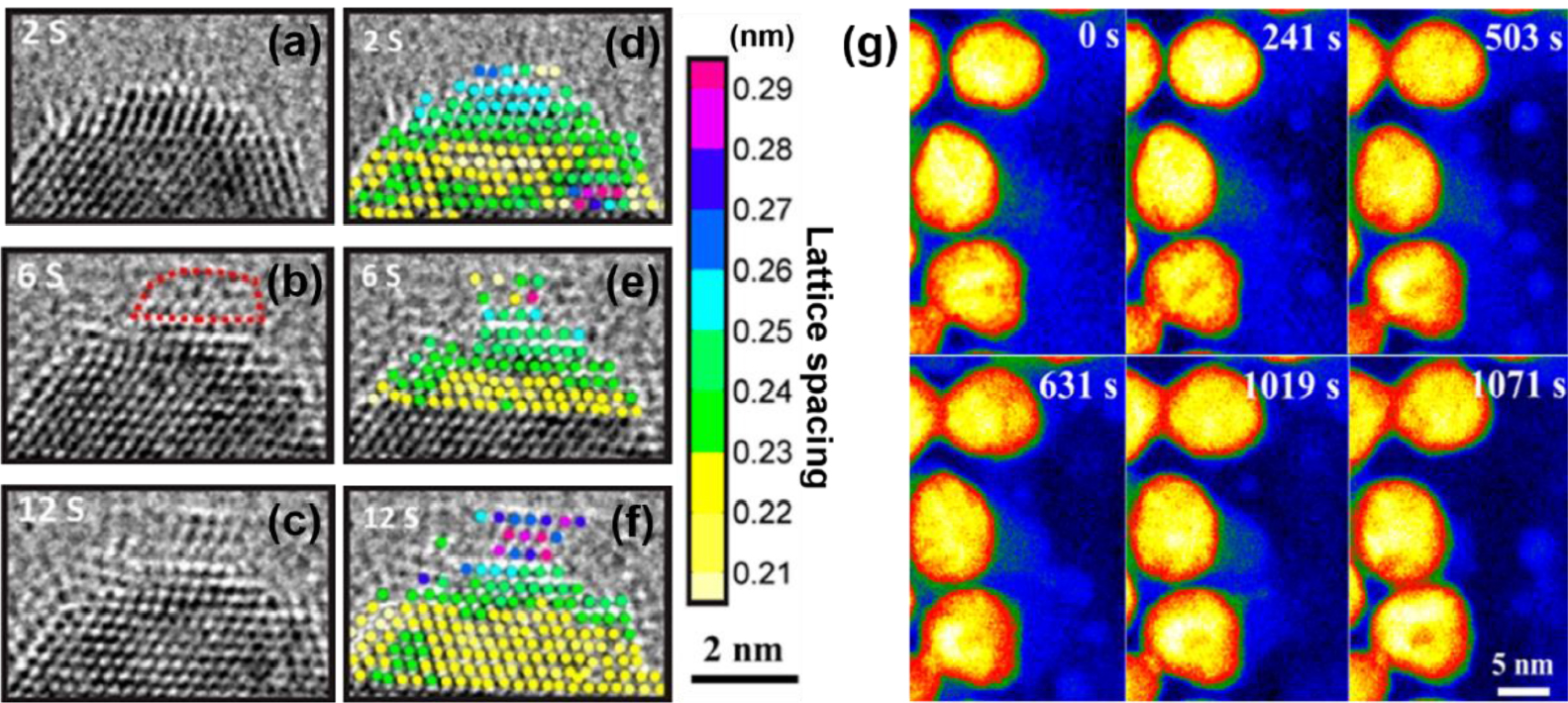 | Fig. 12. (color online) In-situ characterization of Pt0.5Co0.5 nanocrystals during oxidation and reduction reactions. HRTEM images showing the CoO-island forming behavior in a Pt0.5Co0.5 nanocrystal under 0.1 mbar O2 and 250 °C at 2 s (a), 6 s (b), and 12 s (c), and the corresponding lattice spacing as measured from the HRTEM images ((d)–(f)). (g) STEM-LAADF images for the in-situ reduction of oxidized PtCo nanoparticles under H2 at 400 °C (CoO in blue and the metallic core in yellow).[64] |
The limited pressure around the specimens achievable in an ETEM limits the number of catalytic reactions that can be studied in-situ and causes a knowledge gap between the real working behaviors of catalysts under atmospheric conditions and the results obtained using ETEM. Recent technical advances in nanofabrication of nanoreactors have allowed for atomic resolution in-situ (S)TEM imaging under atmospheric pressure using the state-of-the-art in-situ gas holders, offering new opportunities to probe the catalyst structure under more realistic reaction conditions.
Using such MEMS-based in-situ gas/heating holders, Vendelbo et al. observed an oscillatory behavior of Pt nanoparticles when catalyzing CO oxidation under one atmosphere pressure and heating to 659 K.[65] By simultaneously monitoring the CO pressure (using mass spectroscopy, shown in Fig.
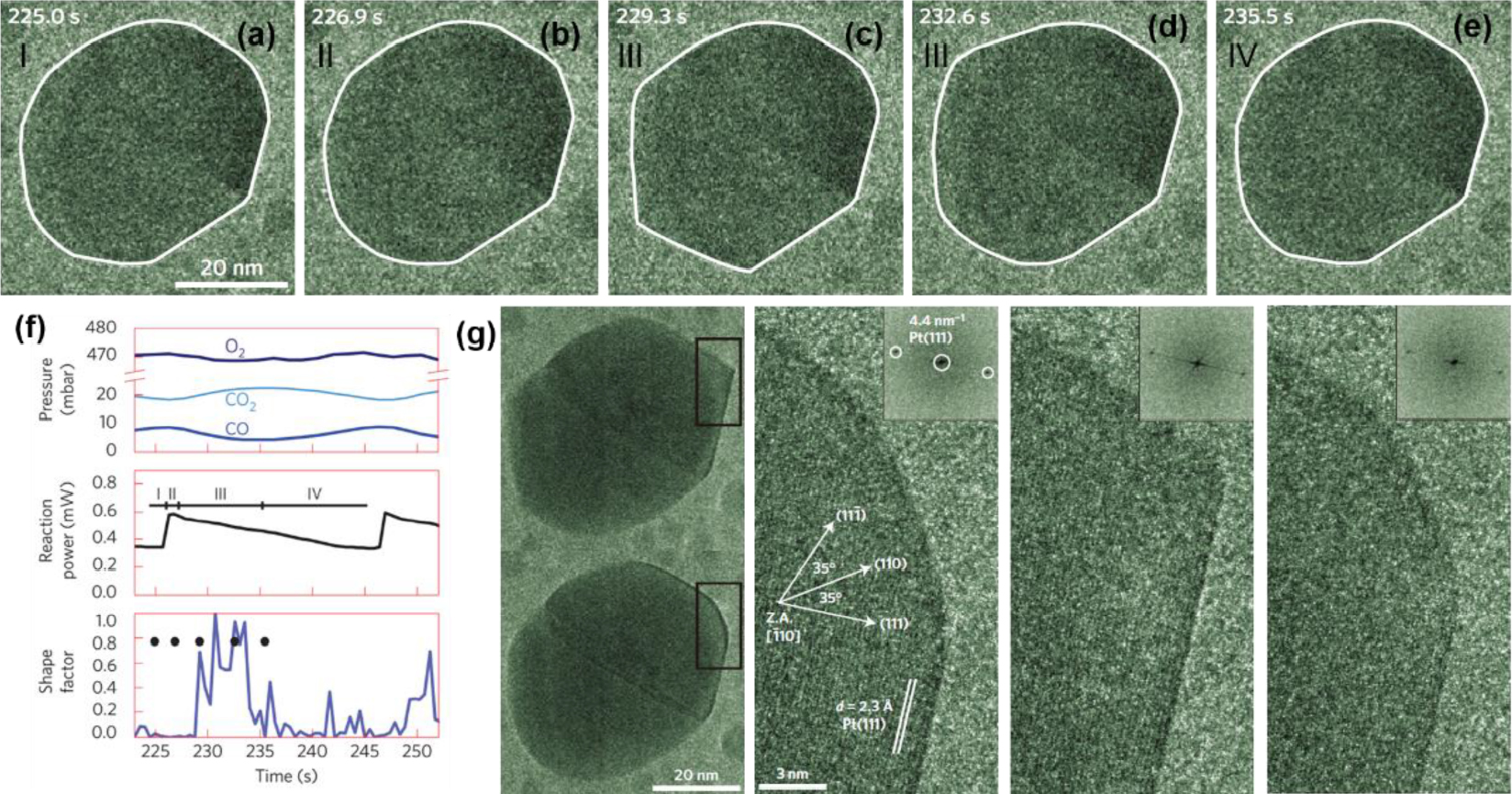 | Fig. 13. (color online) In-situ HTREM imaging of oscillatory behavior for Pt nanoparticles during CO oxidation reaction. ((a)–(e)) A series of in-situ HRTEM images of the morphology evolution of a Pt nanocrystal showing an oscillatory behavior. (f) Real-time mass spectra for probing O2, CO2, and CO pressures, reaction power, and shape factor. (g) Atomic-scale imaging of a single Pt particle with different shapes: the more spherical shape and the more facetted shape.[65] |
Surface faceting behavior was also observed in PdCu nanocrystals under H2 conditions. Jiang et al. used in-situ gas/heating holder to reveal the morphological evolution of PdCu nanocrystals when annealed under the H2 pressure of one atmosphere at 600 K.[66] As the annealing proceeded, the spherical nanocrystal rotated and transformed towards a morphology containing more facets with smaller curvature. Eventually, four flat (001) facets emerged and the nanocrystal transformed into a truncated cube with (001) and (011) facets, shown in Figs. 
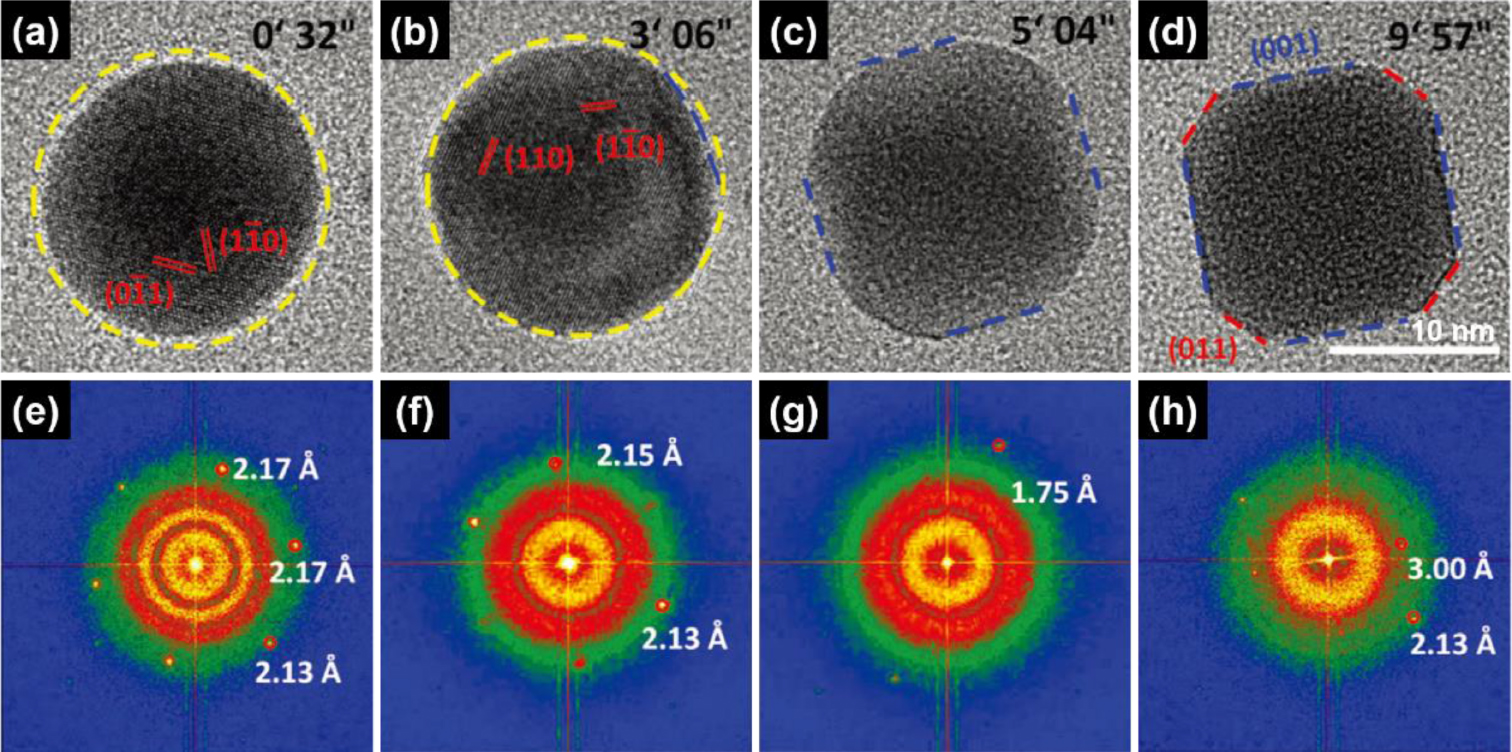 | Fig. 14. (color online) A series of in-situ HRTEM imaging and FFT analysis of a PdCd nanocrystal during annealing under H2 of 1 atmosphere pressure at 600 K. ((a)–(d)) HRTEM images of the surface faceting of the PdCd nanocrystal and ((e)–(h)) the corresponding FFT patterns.[66] |
The incorporation of nanoreactors into TEM not only drastically increases the gas pressure achievable for in-situ experiments, but also makes it possible to perform in-situ STEM-HAADF imaging, which is not feasible in ETEM. For alloy nanocatalysts, the distribution of elements and their diffusion behaviors during thermal annealing are crucial to reveal the structure-property relationship and for tailoring their catalytic performance.[67,68] The implement of in-situ STEM-HAADF imaging provides an excellent way to analyze the compositional evolution of alloy nanoparticles and elucidate the underlying mechanism responsible for these changes. Using a MEMS-type in-situ heating holder, Chi et al. studied the temperature-dependent Pt-segregation in Pt3Co nanoparticles during thermal annealing.[69] Owing to the Z-contrast in the STEM-HAADF images, the segregation of Pt can be easily observed from the increase of image intensity. As shown in Fig.
 | Fig. 15. (color online) STEM-HAADF imaging of a single Pt3Co particle during in-situ annealing. ((a)–(c)) STEM-HAADF images at room temperature (a), 350 °C (b), and 550 °C (c). ((d)–(f)) The corresponding intensity profiles of images (a)–(c) along the yellow dotted boxes.[69] |
Even though the MEMS-based in-situ holders have only been developed for a few years, they have allowed for atomic resolution imaging under both TEM and STEM modes under atmospheric pressure and high heating temperature (
 | Fig. 16. (color online) In-situ STEM imaging of Pt3Co nanocrystals under oxygen environment and elevated temperature. (a) STEM-HAADF image of a Pt3Co nanocrystal after annealing and (b) the corresponding intensity line profiles. (c) False-colored STEM-BF image showing the formation of CoO layers on the Pt3Co {111} surfaces and the corresponding schematic of Co atom arrangement along the CoO 
|
There is no doubt that atomic resolution analytical (S)TEM techniques have played an important role in the study of heterogeneous catalysts. The atomic scale imaging and spectroscopy information obtained from the state-of-the-art (S)TEMs provide a unique way to probe the local structure of the catalysts, complementing the averaged structural information obtained from optical and x-ray techniques. Meanwhile, it should always be kept in mind that the high-energy electron beam may well change the intrinsic structure of the catalyst sample due to irradiation damage. This irradiation effect should be very carefully taken into account when studying the intrinsic structure of catalysts, especially under gas or liquid environments. Even though the recent advances in low-voltage low-electron-dose (S)TEM and high sensitivity detectors has helped to minimize the beam damage effect, irradiation damage is still a major challenge for the study of beam-sensitive materials such as 2D materials, metal-organic frameworks (MOFs) and zeolites. The extra electron dose spent during searching for crystal zone axis, setting up the right imaging conditions and adjusting the accurate defocus value also exacerbate the damage. The newly developed direct electron detection cameras are expected to overcome this challenge by drastically reducing the electron dose required for high-resolution imaging.[73,74] Further combined with sophisticated algorithms and imaging techniques, such as compressive sensing, inpainting and ptychography, the development towards ultra-low-electron-dose imaging should enable direct imaging of extremely beam sensitive materials at the atomic level. Furthermore, cryo-TEM (cryogenic transmission electron microscopy) is another promising tool to probe electron-beam sensitive specimens. Cryo-TEM has been extensively used in the study of biological samples, and has also found important applications in material science.[75,76] Under low temperature (approximately 100 K) and low-dose (
As discussed in the second part of this review article, STEM-HAADF tomography can now achieve atomic resolution in 3D owning to advances both in instrumentation and reconstruction algorithms. However, using the Z-contrast of STEM-HAADF imaging to identify and separate the spatial distribution of different elements in tomography reconstruction is still challenging, especially when the elements have similar atomic numbers. Combining atomic-resolution spectroscopy (EDXS or EELS) and tomography offers a possible way to reconstruct the 3D structure with detailed chemical information and atomic resolution. For this purpose, new techniques and data processing algorithms must be developed to drastically cut off the electron dose required for tomography with spectroscopy signals in order for the catalyst particles to survive during the experiments.
The recent development of in-situ techniques has allowed for direct imaging of the dynamically structural and compositional evolution of catalysts at the atomic scale under more realistic reaction conditions involving gas pressure and elevated temperatures. However, temporal resolution is still a bottleneck for in-situ (S)TEM for the study of dynamical events, whereas catalytic reactions usually feature high-frequency dynamics such as nucleation, atomic diffusion, and surface reconstruction. Thus, combining ultra-fast electron microscopy[77,78] with in-situ techniques and fast cameras may provide a promising solution to improve the temporal resolution of (S)TEM for the study of structural dynamics during catalytic reactions. However, it should be kept in mind that the structural changes under the excitation of ultra-fast pulse laser may deviate from the intrinsic structural evolution occurring under realistic catalytic reactions, and the intense electron pulse might also cause damage to the catalyst particles (if working under dynamic TEM (DTEM) mode[79,80]). Special cares will need to be taken when probing the fast dynamics of catalysts using ultra-fast electron microscopy.
| [1] | |
| [2] | |
| [3] | |
| [4] | |
| [5] | |
| [6] | |
| [7] | |
| [8] | |
| [9] | |
| [10] | |
| [11] | |
| [12] | |
| [13] | |
| [14] | |
| [15] | |
| [16] | |
| [17] | |
| [18] | |
| [19] | |
| [20] | |
| [21] | |
| [22] | |
| [23] | |
| [24] | |
| [25] | |
| [26] | |
| [27] | |
| [28] | |
| [29] | |
| [30] | |
| [31] | |
| [32] | |
| [33] | |
| [34] | |
| [35] | |
| [36] | |
| [37] | |
| [38] | |
| [39] | |
| [40] | |
| [41] | |
| [42] | |
| [43] | |
| [44] | |
| [45] | |
| [46] | |
| [47] | |
| [48] | |
| [49] | |
| [50] | |
| [51] | |
| [52] | |
| [53] | |
| [54] | |
| [55] | |
| [56] | |
| [57] | |
| [58] | |
| [59] | |
| [60] | |
| [61] | |
| [62] | |
| [63] | |
| [64] | |
| [65] | |
| [66] | |
| [67] | |
| [68] | |
| [69] | |
| [70] | |
| [71] | |
| [72] | |
| [73] | |
| [74] | |
| [75] | |
| [76] | |
| [77] | |
| [78] | |
| [79] | |
| [80] |

